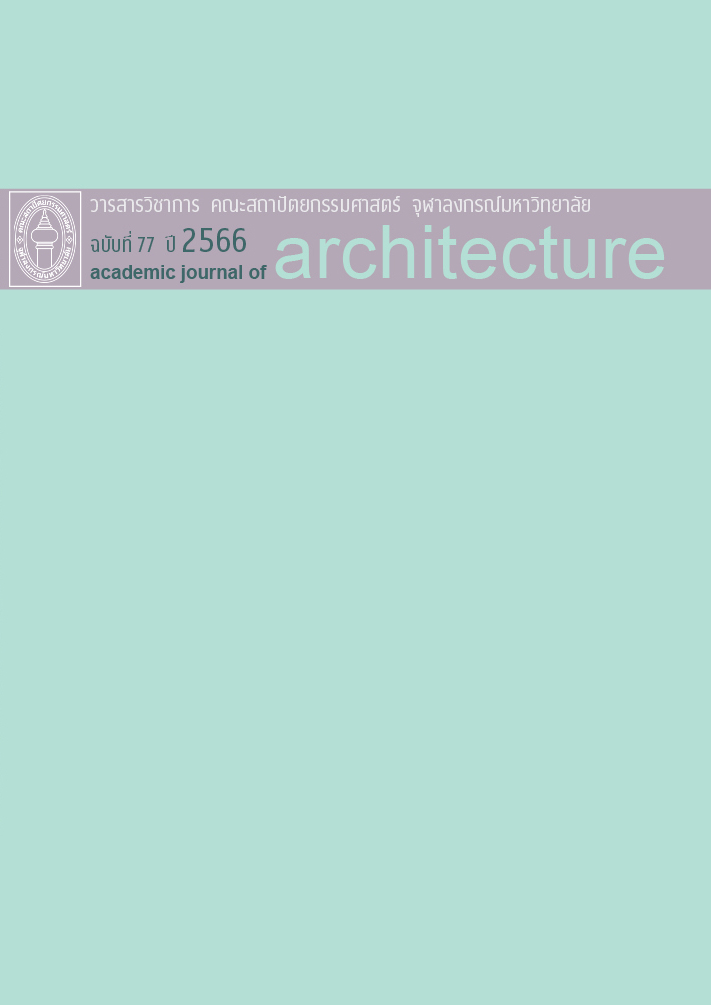Ordinary Urban Heritage: Pattern and Transformation of Thai Spirit Houses, Case Study in Bangrak District
Main Article Content
Abstract
Ordinary Urban Heritage is an alternative view of Culture Heritage. In contrast to the international conservation concept that focuses on national and official heritage, the concept of Ordinary Urban Heritage esteems the cultural heritage inherent in the everyday activities of ordinary people. The Thai spirit houses, also known as Saan Phra Phum, have held a revered position within Thai society for a long time. This spirit house represents the belief of the dwellings of guardian spirits, safeguarding homes and buildings, which this belief has transmission from generation to generation. but these cultural significances are overlooked in the context of Cultural Heritage today. Furthermore, they face the risk of destruction by the transformation of community space. This article elucidates the potential of Saan Phra Phum to assume an ordinary urban heritage. By sorting them against five selection criteria — the amount of time that the heritage has existed, their association with ordinary people, repetitive appearances or clustering, adaptability to urbanization, and the existence of heritage. it becomes evident that they merit recognition as Ordinary Urban Heritage. Moreover, the Thai spirit houses serve as valuable representations that shed light on patterns and transformations occurring amid the processes of urbanization and multicultural societies in the Bangrak District.
Article Details
References
Ahmad, Y. (2006, May). The scope and definitions of heritage: From tangible to intangible. International Journal of Heritage Studies, 12(3), 292-300.
Ambhanwong, S. (1995). Phraphum chao thi (3 rev. ed.). The Khurusapha Trade Organization.
Brereton, J. P. (1987). Sacred space. In L. Jones (Ed.), Encyclopedia of religion (2 nd. ed., Vol. 12, pp. 7978-7986). Thomson Gale.
Carr-Gomm, P. (2008). Sacred places: Sites of spiritual pilgrimage from Stonehenge to Santiago de Compostela. Quercus.
Chaiyapotpanit, A. (2017). Gods in the Chinese Shrines of Bangkok: Their styles, related beliefs and relationship with the Chinese communities. Research and Development Institute, Silpakorn University.
Davidson, K. (1996). Spirit house worship in Bangkok's modern context [Unpublished master thesis]. Chulalongkorn University.
Duke, P., & Bunnag, P. (1986). The Chinese community in Bangkok: Continuity and changes. The Institute of Thai Studies Academic Affairs, Chulalongkorn University-The Ford Foundation.
Eoseewong, N. (2019). Buddhism-Brahmanism-Animism or Animism-Brahmanism-Buddhism? In K. Uitekkeng, V. Panich, & S. Laomanacharoen (Eds.), Animism-Brahmanism-Buddhism in Thai religion. Nata-Haek.
Hoskin, J. (1992). A guide to Thailand. Asia Books.
Jhearmaneechotechai, P. (2022). Selection criteria of ordinary urban heritages through the case of Bangrak, a multi-cultural & old commercial district of Bangkok. Nakhara: Journal of Environmental Design and Planning, 21(2), 1-29.
Kaewsonthi, A. (1950). Phraphum chaothi. In Seven numbers scripture and the horoscope consideration (pp. 48 - 57), published for the funeral of Mr.Khian and Mrs.Phut Kaewsonthi, 5 Febuary 1950. Wittayakorn.
Kladsap, W. (2012). Management of land-spirit shrine in Bangkok [Unpublished master thesis]. Silpakorn University.
Klauaymai na Ayudhya, T. (1971). Bòt kwaam laang rêuang (chút têe sŏng): Săan làk bâan. In published for the funeral of Mrs. Toem Klauaymai na Ayudhya, at Wat Thep Sirin Tharawat cemetery, 18 May 1971. Aksorn Siam.
Midet, R. (1955). Mythology and installation of the phra phum shrine. In published for the funeral of the noble title Khun Pisankuruniti (Choei Chaiyakul), at Wat Prayurawongsawas cemetery, 1 May 1952. Thai Bithaya.
Nibhatsukit, W. (2021, July-December). Changes in the Bangrak area after the construction of Charoen Krung Road during the Reign of King Rama IV-VI (1851-1925). Journal of the Faculty of Arts, Silpakorn University, 43(2), 1-22.
Oyarzun, F. P. (2017). Heritage today: The art of transforming what we received from the past. Built Heritage, 3, 60-68.
Papadam, M. (2017). Heritage of the ordinary: An alternative view; Strategies for using cultural heritage sites as a driver of sustainable urban [re] deveopment in Piraeus [Unpublished master thesis]. Delft University of Technology.
Petti, L., Trillo, C., & Mauro, M. D. (2018). Heritage and reconstruction: Different perspectives. In J. H. Kruhl, R. Adhikari, & U. E. Dorka (Eds.), Living under the threat of earthquakes: Short and long-term managment of earthquake risks and damage prevention in Nepal (pp. 101-116). Springer. https://doi.org/https://doi.org/10.1007/978-3-319-68044-6
Phinkhanngoen, W. (1968). Phraphum chao thi. In Alphabetical order of Thai fine arts and hygienic documents (pp. 58-61), published for the funeral of Mr.Thawin Chimdi, 13 January 1968. Liang-siang Chongcharoen Printing House.
PhrayaAnumanrajadhon. (1952). Phisang thewada. In published for the funeral of Mrs.hía Satiankoset, at Wat Makut Kasatriyaram cemetery, 1 May 1952. Phra Chan Printing House.
PhraYannawet. (1951). Soroj-Puram scripture for construction house and fence. In the cremation of Mr.Suk Suk-choti (Phra Yannawet) 16 December 1951 (pp. 33-35). Thai-Khasem Printing House.
Pinthasut, W. (1970). Phraphum chao thi [Unpublished graduate thesis]. Silpakorn University.
Podder, A. K., Hakim, S. S., & Bosu, S. P. (2018). Ordinary heritage. Archnet-IJAR: International Journal of Architectural Research, 12(2), 334-346.
Sapu, S. (2018). The vernacular city as ordinary cultural heritage. Journal of Mekong Societies, 14(2), 63-90.
Satiankoset. (1971). Thai traditions study. http://www.openbase.in.th/files/satienbook032.pdf
Sievers, W. (1966). Street scene with Japan Airlines Building on right, Bangkok. In nla.obj-161445885 (Ed.). Department of Trade and Industry.
Sikkhakosol, T. (2022, January 28). What do Chinese people worship during Chinese new year and other Chinese festivals? and why worship? SILPA-MAG.com. https://www.silpa-mag.com/culture/article_82052
Sirisakdamkeong, P. (2006). Multiculturalism. Peace Resource Collaborative.
Smith, L. (2015). Intangible heritage: A challenge to the authorised heritage discourse? Revista d’Etnologia de Catalunya, 40, 133-142.
Sodsongkrit, M. (2016). An inscription of Chinese religious places in Ubon Ratchathani province. Ubon Ratchathani University Printing House.
Sowannee, W. (2010). Meaning and sense of Thai sacred places. DEC journal, Faculty of Decorative Arts, Silpakorn University, 3, 4-18.
Sukmanas, N. (1996). The beliefs in Feng-Shui as a way of life of Chinese Thais in Bangkok [Unpublished master thesis]. Chulalongkorn University.
Tapananont, N., Chantachot, P., & Chiamprasert, A. (2016, December). Shophouses and present-day living. Academic Journal of Architecture, Chulalongkorn University, 63, 69-84.
UNESCO. (2022). Basic texts of the 2003 convention for the safe guarding of the intangible cultural heritage (2022 Edition ed.). https://ich.unesco.org/en/basic-texts-00503
Yimkamphu, T., & Phenrat, P. (1964). The manual for phra phum and details of installation, worship, and sacrifice. Kasembannakij.


